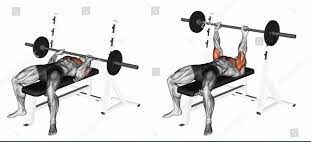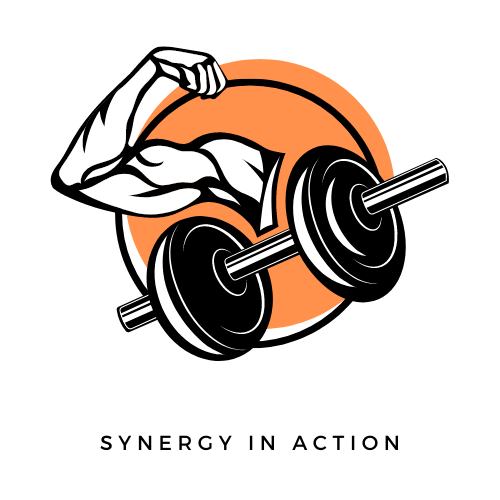The quest for increased strength and muscle mass has been a driving force in the world of fitness for decades. Among the myriad of exercises designed to help achieve these goals, the bench press stands as an iconic and essential compound movement. Whether you’re a seasoned lifter or just starting on your fitness journey, understanding the nuances of the bench press and exploring potential performance-enhancing avenues like anabolic steroids can provide valuable insights into maximizing your gains.
Section 1: Fitness Tips for Improving Your Bench Press: Perfect Your Form

When it comes to strength training, mastering the art of the bench press can have a profound impact on your overall strength and physique. The secret to unlocking its full potential lies in perfecting your form. In this section, we’ll delve into the significance of proper bench press technique and break down key form elements that will help you maximize your gains while minimizing the risk of injury.
The Crucial Role of Proper Form
Picture this: you’re lying on a bench, hands gripping the barbell above you, muscles poised to lift. It’s a scene repeated countless times in gyms across the world. Yet, what sets apart a successful bench press from a potentially dangerous one is the mastery of form. Proper form isn’t just a suggestion; it’s the foundation upon which your bench press prowess is built.
-
Tip 1: Perfect Your Form

Before you even consider adding more plates to the bar, take a step back and ensure that your form is impeccable. Not only does proper form enhance the effectiveness of the exercise, but it also reduces the risk of injury. As you lie on the bench, remember that quality triumphs over quantity.
Key Form Elements
- Grip Width: Your grip width has a direct impact on which muscles are engaged during the lift. A wider grip places greater emphasis on your chest muscles, while a narrower grip shifts the focus to your triceps. Finding the optimal grip width for your body and goals is essential. Keep your hands slightly wider than shoulder-width apart to strike a balance between chest and triceps activation.
- Bar Path: As you lower the bar to your chest, aim for a controlled descent. The bar should touch your mid-chest, just below your nipple line. Avoid flaring your elbows out excessively, as this can strain your shoulder joints. Instead, keep your elbows at a 45-degree angle from your body, maintaining tension in your chest and triceps.
- Foot Placement: Your feet play a vital role in providing a stable base for the lift. Plant your feet firmly on the ground, approximately hip-width apart. This not only aids in generating power but also prevents your lower back from arching excessively. Keeping your feet grounded helps maintain a solid foundation for a powerful press.
- Arch Your Back: A slight arch in your lower back helps create a natural curve that promotes stability and engages your chest muscles. However, be cautious not to exaggerate the arch, as this can lead to discomfort or injury. Focus on maintaining a neutral spine while creating a subtle arch to optimize muscle activation.
- Tighten Your Shoulder Blades: Before unracking the bar, retract your shoulder blades and squeeze them together. This creates a stable platform for your shoulders and upper back, reducing the risk of strain. As you lower the bar, maintain this tightness to ensure proper shoulder positioning.
- Engage Your Core: A strong core provides the necessary stability for the bench press. Engage your abdominal muscles throughout the lift to support your spine and prevent excessive arching. This not only enhances your overall strength but also promotes proper form.
Practice Makes Perfect: Perfecting your bench press form takes time, patience, and practice. Don’t rush the process; focus on honing your technique before attempting heavier weights. Consider seeking guidance from a knowledgeable fitness professional or coach who can provide personalized feedback and corrections.
Tip 2: Focus on Progressive Overload: Building Strength Through Consistent Progression

Progressive overload is akin to the cornerstone of a majestic castle. It’s the principle that stands at the heart of muscle growth, strength enhancement, and the pursuit of a powerful bench press. This second tip delves into the essence of progressive overload, its significance, and how it serves as a steadfast guide on your journey to a stronger, more formidable bench press.
The principle of progressive overload is the driving force behind muscle hypertrophy—the process of muscle cells expanding in response to increased workload. When you lift weights that are heavier than what your muscles are accustomed to, micro-tears occur in the muscle fibres. As your body repairs these micro-tears, your muscles grow back stronger and more resilient.
Implementing Progressive Overload in Bench Press Training
- Start Conservatively: If you’re new to the bench press or returning after a break, begin with a weight that challenges you but allows you to maintain proper form. Over time, incrementally increase the weight by small increments, such as 2.5 to 5 pounds, to facilitate a gradual progression.
- Adjust Reps and Sets: As you increase the weight, consider adjusting your rep and set scheme. For instance, you might start with 3 sets of 8-10 reps and then progress to 4 sets of 6-8 reps with heavier weights. This change in rep and set range helps optimize muscle growth.
- Periodization: Incorporate periodization into your training routine. This involves alternating between phases of higher and lower intensity to prevent plateaus and promote continuous gains.
Tip 3: Strengthen Supporting Muscles: The Bench Press Ecosystem
While the bench press is undoubtedly the star of the show, it’s important to recognize that it operates within an intricate ecosystem of supporting muscles. These muscles play a pivotal role in stabilizing the lift, generating power, and ensuring balanced muscular development. Let’s take a closer look at the key muscle groups involved and explore how strengthening them can lead to a more effective bench press.
- Shoulders (Deltoids): The anterior deltoids assist in pressing the bar off your chest, while the lateral and posterior deltoids help stabilize the movement and control the bar path.
- Triceps: The triceps are essential for extending your elbows and completing the lockout phase of the lift.
- Back (Upper and Lower): The upper back muscles, including the rhomboids and traps, provide stability during the bench press. A strong lower back supports the arching of the spine and contributes to overall bench press power.
Accessory Exercises to Strengthen Supporting Muscle Groups
- Overhead Press: This exercise targets the shoulders and complements the bench press by enhancing shoulder strength and stability.
- Tricep Dips: Tricep dips are excellent for isolating and strengthening the triceps, which are crucial for completing the pressing motion.
- Rows: Incorporate rows—such as barbell rows or cable rows—to fortify your upper back muscles, promoting stability during the bench press.
- Lat Pulldowns: A strong back is vital for maintaining proper form. Lat pulldowns engage the upper back and contribute to bench press stability.
- Face Pulls: Face pulls target the rear deltoids, which aids in balancing shoulder development and supporting overall shoulder health.
- Push-Ups: Push-ups engage multiple muscle groups, including the chest, shoulders, and triceps, providing a comprehensive upper-body workout.
Ultimately, the bench press is not an isolated movement; it’s a symphony of muscle groups working in harmony to lift that barbell. By strengthening the supporting muscles through targeted accessory exercises, you create a robust foundation for your bench press journey. This not only enhances your performance but also reduces the risk of imbalances or injuries.
Tip 4: Incorporate Variations – Elevate Your Bench Press Game with Strategic Variation

While the classic flat bench press is a stalwart in any strength training regimen, incorporating variations introduces a new dimension to your workout. Variations in the bench press allow you to engage different muscle fibres and regions of the targeted muscle groups.
Incline bench press involves adjusting the bench to an incline, targeting the upper portion of your chest and shoulders, contributing to well-rounded chest development. On the other hand, the decline bench press shifts the emphasis to the lower pectoral muscles, placing greater tension on the lower chest fibres, achieving a balanced aesthetic. Finally, the close-grip bench press involves a narrower grip, primarily engaging the triceps while still targeting the chest, to enhance lockout power during the standard bench press.
Preventing Plateaus and Igniting Growth
The human body is a master at adaptation. As you continue to challenge your muscles with the same exercise routine, progress can plateau over time. This is where bench press variations shine. By introducing novel movements, you provide a fresh stimulus that your muscles aren’t accustomed to. This, in turn, reignites growth and prevents stagnation.
How to Incorporate Variations
- Periodic Rotation: Periodically swap out your standard bench press with variations. For instance, you might focus on an incline bench press for a few weeks before transitioning to decline or close-grip variations.
- Accessory Work: Utilize variations as accessory exercises following your primary bench press session. This approach allows you to target specific muscle groups without compromising the core movement.
- Progressive Overload Still Applies: Remember, even with variations, the principle of progressive overload remains paramount. Gradually increase the weight you lift to continue stimulating muscle growth.
Section 2: Enhancing Bench Press Gains with Accessory Exercises

While the bench press is undeniably a cornerstone of upper body strength development, honing in on accessory exercises can elevate your performance to new heights. These supplemental movements, such as dumbbell presses, incline bench presses, and tricep-focused exercises, offer a specialized approach to muscle engagement, helping you overcome weaknesses, foster balanced muscle development, and ultimately propel your bench press prowess to the next level.
The Power of Accessory Exercises: Targeted Muscle Activation
- Dumbbell Presses: Expanding Range of Motion and Stabilization
Dumbbell presses are a staple in the toolkit of any serious lifter aiming to enhance their bench press prowess. Unlike barbell presses, dumbbell presses require a higher degree of stabilization due to the independent movement of each arm. This heightened demand for stability engages a plethora of smaller stabilizing muscles, contributing to a more well-rounded and resilient upper body.
By incorporating dumbbell presses, you not only challenge your chest, shoulders, and triceps but also stimulate the activation of the often-neglected stabilizers. Over time, this increased muscle activation translates to enhanced control and balance during your bench press, allowing you to tackle heavier weights and achieve greater gains confidently.
- Tricep-Focused Movements: Strengthening Lockout Power
The triceps play a crucial role in the final phase of the bench press—the lockout. Strengthening your triceps can provide the extra push needed to conquer heavier weights and complete your bench press with confidence. Tricep-focused movements, such as skull crushers, tricep dips, and close-grip bench presses, directly target these muscles, fostering increased power and stability during the lockout phase.
By dedicating attention to your triceps through accessory exercises, you bolster the finishing touch of your bench press, enhancing your ability to overcome sticking points and set new personal records. The result? A more robust and effective bench press that exemplifies well-rounded upper body strength.
Section 3 Rejuvenation – The Crucial Role of Rest and Recovery
It’s essential to recognize that real growth occurs not in the gym but during periods of rest and recovery. As your muscles undergo the stress of intense workouts, they require time to repair and rebuild. By prioritizing restful sleep, maintaining a balanced diet, and allocating ample recovery time between bench press sessions, you lay the foundation for sustainable progress, safeguarding against the pitfalls of overtraining and reducing the risk of injury.
The Art of Rest and Recovery: Building Blocks of Success
- Adequate Sleep: The Bedrock of Muscle Repair
Sleep isn’t just a luxurious indulgence; it’s a fundamental pillar of effective recovery. During sleep, your body enters a state of repair and rejuvenation, essential for muscle growth and overall wellness. Aim for 7-9 hours of quality sleep each night to optimize protein synthesis, hormone balance, and mental clarity. Adequate sleep ensures you wake up ready to tackle the challenges of the day, including the demands of your bench press journey.
- Balanced Diet: Fueling Your Muscles for Recovery
Nutrition plays a pivotal role in the recovery process. Consuming a balanced diet rich in protein, healthy fats, complex carbohydrates, and essential vitamins and minerals provides the necessary building blocks for muscle repair and growth. Adequate protein intake supports protein synthesis, aiding in the recovery of micro-tears incurred during intense bench press sessions. Hydration, too, is paramount—maintain proper fluid levels to support cellular functions and optimize nutrient transport.
- Strategic Recovery Periods: Unleashing Progress
The allure of frequent bench press sessions may tempt you to overlook the significance of recovery time. However, rest is not a sign of weakness but a strategic tool to maximize your gains. Adequate recovery time allows muscles, tendons, and ligaments to adapt and grow stronger. Aim to space out your bench press workouts to provide sufficient time for recovery. Overtraining can lead to decreased performance, stalled progress, and increased susceptibility to injury—outcomes you’d undoubtedly want to avoid.
Synergy in Action: Combining the Bench Press with Accessory Exercises

The synergy between the bench press and accessory exercises is where the true magic happens. By strategically integrating these supplemental movements into your routine, you create a dynamic training regimen that addresses both broad muscle groups and intricate stabilizers. This comprehensive approach not only enhances your bench press performance but also promotes balanced muscle development, minimizes the risk of imbalances, and contributes to overall functional strength.
Additionally, harness the cognitive dimensions of your bench press by fostering a potent mind-muscle connection. Visualize success, engage your senses, and channel your intentions into purposeful contractions. The fusion of physiological and mental mastery propels your bench press to heights previously unattainable, unlocking a realm of untapped potential and setting the stage for a truly transformative strength journey.
Section 4: Anabolic Steroids: What You Need to Know

Anabolic steroids, often referred to simply as “steroids,” are synthetic compounds that mimic the effects of testosterone—a naturally occurring hormone responsible for muscle growth, bone density, and the development of male characteristics. These compounds bind to androgen receptors in muscle cells, stimulating protein synthesis and promoting muscle tissue growth. In the world of fitness and sports, anabolic steroids have garnered attention for their potential to deliver rapid and significant gains in muscle mass and strength.
Potential Effects on Muscle Growth and Performance
Anabolic steroids possess undeniable potency when it comes to fostering muscle growth and boosting athletic performance. Users often report increased muscle size, improved recovery, and heightened workout intensity. The allure of these results, especially in a culture that celebrates strength and aesthetics, has led to their popularity among some segments of the fitness community.
While anabolic steroids may offer alluring promises, athletes and fitness enthusiasts alike are urged to approach anabolic steroids with caution and a deep understanding of the risks involved. The use of these substances outside of medical necessity is widely frowned upon due to their potential side effects and ethical implications.
In one of our blog posts, you will find a compilation of information regarding frequently used anabolic substances and peptides to aid in enhancing fitness levels and promoting muscle growth.
Takeaway: An Informed Approach to Strength Enhancement
The bench press stands as a cornerstone of upper body strength development, offering a myriad of benefits for both novice and experienced lifters. By prioritizing proper technique, gradual progression, and comprehensive recovery, you can optimize your bench press performance and achieve remarkable results. While the allure of anabolic steroids may tempt some, it’s essential to approach this path with full awareness of the potential risks and ethical considerations.
Remember, the journey toward enhanced strength and muscle mass is a marathon, not a sprint. Prioritize your health, stay committed to consistent training, and make informed decisions that align with your long-term goals. By combining dedication, knowledge, and a disciplined approach, you can achieve your bench press goals while maintaining your overall well-being.

